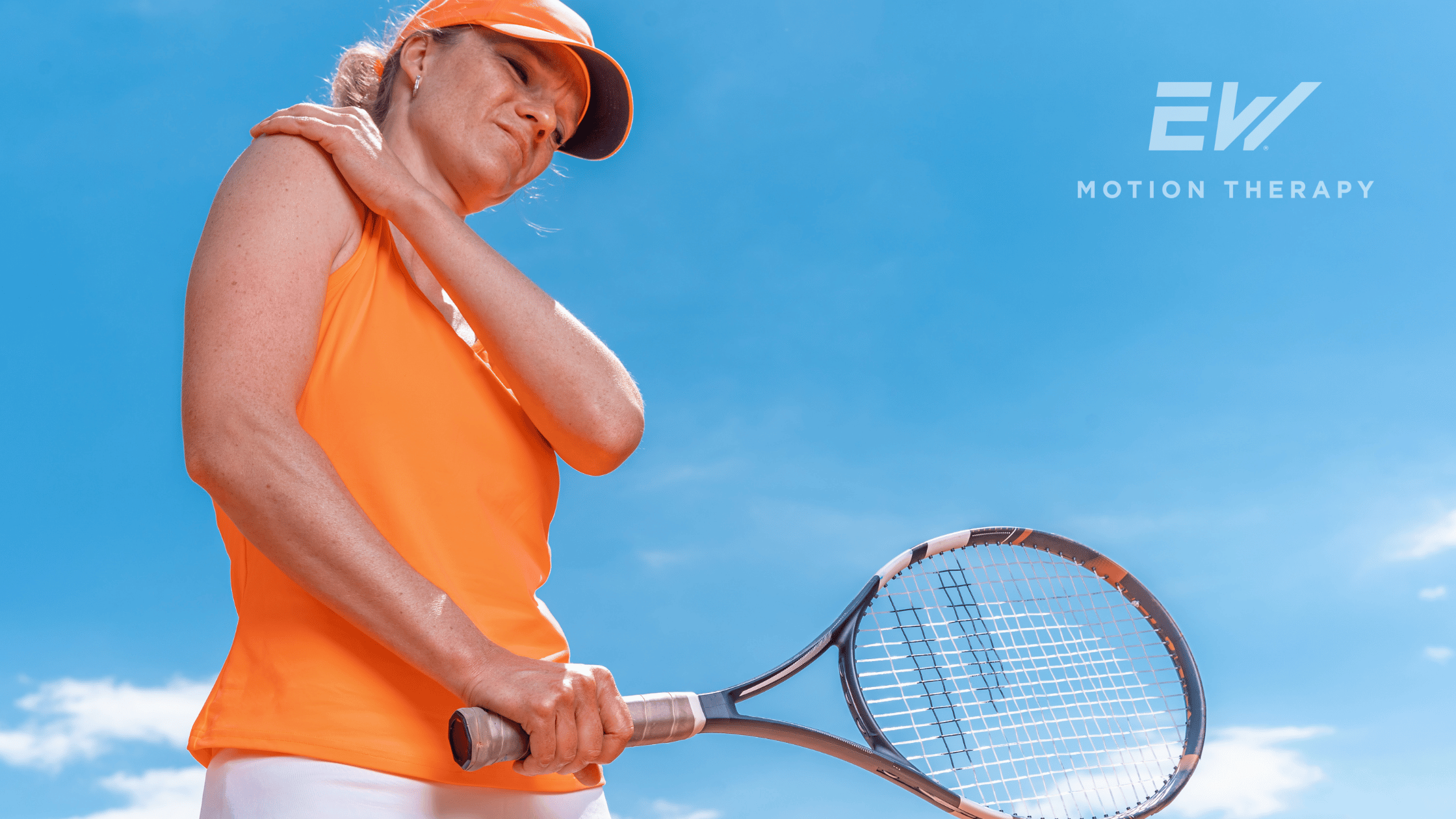Shoulder Injuries in Tennis Players: Symptoms and the Role of Physical Therapy

Licensed Physical Therapist, PT, DPT // EW Motion Therapy Homewood
Shoulder injuries are a frequent concern among tennis players, often hindering performance and leading to extended periods away from the court. Understanding the nature of these injuries, why they occur, and how to effectively address them is crucial for tennis players of all levels. Physical therapy can be an excellent treatment option for tennis players, whether recovering from an injury or wanting to prevent them better - we consider it a privilege to help our tennis players with these efforts at EW Motion Therapy. Even if you decide that our services don’t fit your needs, this article will explore the most common shoulder injuries in tennis players, why they are so prevalent, and how physical therapy plays a vital role in both recovery and prevention.
Why are shoulder injuries common among tennis players?
Tennis is a sport that places significant demands on the shoulder, and several factors contribute to the high incidence of shoulder injuries:
Repetitive overhead motions
Tennis involves frequent overhead movements, such as serves and overhead smashes, which continuously stress the shoulder joint. The repetitive nature of these actions can lead to overuse injuries, particularly in the rotator cuff tendons.
High velocity and force
The force generated during a serve or an overhead smash can exceed 800 pounds of force, creating substantial strain on the shoulder's muscles, tendons, and ligaments. The acceleration and deceleration forces involved in these movements can cause microtrauma, which accumulates over time.
Improper technique
Using incorrect technique or form during strokes, especially serves, can increase the likelihood of shoulder injuries. Poor mechanics can place undue stress on the shoulder, leading to improper load distribution and increased injury risk.
Inadequate conditioning and warm-up
Failure to properly warm up or maintain shoulder strength and flexibility can predispose tennis players to injuries. A lack of conditioning can lead to muscle imbalances, reduced stability, and increased susceptibility to injury during high-intensity play.
Common shoulder injuries in tennis players
The shoulder is a complex joint that allows for a wide range of motion. Still, this complexity also makes it vulnerable to various injuries, especially in sports like tennis that demand repetitive overhead movements. Here are the most common shoulder injuries among tennis players:
Rotator cuff tendinitis and tears
The rotator cuff comprises four muscles and their tendons, which stabilize the shoulder joint. Overuse, particularly from repeated serving or overhead strokes, can lead to inflammation of these tendons, known as rotator cuff tendinitis. If the condition persists without proper treatment, it can progress to partial or complete tears of the tendons.
Symptoms:
- Pain in the shoulder, especially when raising the arm
- Weakness in the shoulder, making it difficult to perform everyday tasks
- A clicking or popping sensation during shoulder movements
Shoulder impingement syndrome
This condition occurs when the rotator cuff tendons are pinched or compressed during arm movements, particularly when lifting the arm overhead. Repeated impingement can cause inflammation, swelling, and pain, decreasing shoulder function.
Symptoms:
- Sharp pain when lifting the arm, especially overhead
- Pain that worsens at night or with repetitive activities
- Limited range of motion in the shoulder
Labral tears
The labrum is a ring of cartilage that surrounds the shoulder socket, providing stability. Repetitive overhead motions or a sudden traumatic event, like a fall, can cause labrum tears. The most common type in tennis players is a SLAP tear (Superior Labrum Anterior and Posterior).
Symptoms:
- Deep shoulder pain, often felt during specific movements
- A catching or locking sensation in the shoulder
- Decreased strength and stability, particularly in overhead movements
Bursitis
Bursitis involves inflammation of the bursa, a fluid-filled sac that reduces friction between shoulder tissues. Repetitive movements or prolonged pressure on the shoulder can irritate the bursa, leading to pain and swelling.
Symptoms:
- Tenderness and swelling around the shoulder
- Pain when moving or pressing on the shoulder
- Stiffness and discomfort, especially after activity
How physical therapy can help with recovery and prevention
Physical therapy is a cornerstone of shoulder injury recovery and prevention in tennis players. A tailored approach that addresses the athlete’s needs can significantly enhance shoulder health and performance.
Assessment and diagnosis
Physical therapists conduct a thorough assessment to identify the exact nature of the shoulder injury, including evaluating range of motion, strength, and any biomechanical issues that may contribute to the problem. This detailed evaluation allows for a personalized treatment plan that targets the root cause of the injury.
Rehabilitation exercises
Rehabilitation exercises are designed to restore shoulder function, improve strength, and enhance flexibility. For rotator cuff injuries, exercises may include resistance band work, shoulder stabilizing movements, and gradual progression to more sport-specific activities.
External and internal rotation
These exercises strengthen the rotator cuff muscles, critical for shoulder stability.
Isometric Standing Shoulder External Rotation in Abduction: Begin in a standing upright position with one arm out to the side and elbows bent 90 degrees, palm facing forward, holding a resistance band. You should be facing the anchor point. Walk backward one step at a time before returning to the start position. Make sure to keep the same arm position as you step backward. Maintain a gentle chin tuck throughout the exercise, and do not let your back arch.

Shoulder Internal Rotation in Abduction with Anchored Resistance: Begin standing upright with your arm out to the side, bent at 90 degrees, holding a resistance band anchored behind you at shoulder height. Rotate your arm forward without letting your elbow drop, then slowly return to the starting position and repeat. Keep your back straight, and do not shrug your shoulder during the exercise.

Scapular stabilization exercises
Focusing on the muscles that control the shoulder blade helps improve overall shoulder mechanics and reduces impingement risk.
Shoulder Extension with Resistance: Begin standing upright with your arms straight forward and palms facing inward, holding the ends of a resistance band anchored overhead in front of you. Pull your arms down to your sides, squeezing your shoulder blades together. Then, bring them back up to the starting position and repeat. Keep your elbows and back straight, and do not shrug your shoulders during the exercise.

Scapular Retraction with Resistance: Begin standing upright with your elbows bent and tucked at your sides, holding the ends of a resistance band that is anchored in front of you. Squeeze your shoulder blades together and downward, pulling against the resistance band. Hold this position, then relax and repeat. Make sure to keep your back straight and do not shrug your shoulders during the exercise.

Manual therapy and modalities
Manual therapy techniques, such as joint mobilization, soft tissue massage, and stretching, can alleviate pain, reduce inflammation, and improve shoulder mobility. Physical therapists may also use therapeutic modalities like TENS (electrical stimulation) or iontophoresis (an electrically charged patch that delivers medication) for pain management.
Technique correction and sport-specific training
A key aspect of preventing future injuries is addressing any technical flaws in a player's stroke mechanics. Physical therapists can work with tennis coaches to provide biomechanical analysis and suggest adjustments that minimize shoulder strain. Sport-specific training that simulates on-court movements ensures that rehabilitation exercises translate effectively to actual play.
Injury prevention programs
Physical therapy is not only about recovery but also about prevention. If you are an avid tennis player, ensure you are involved in a tennis-specific injury prevention program that looks at form and biomechanics and sees how everything works together, paying attention to the entire chain of joints and muscles. Injury prevention programs can include:
- Strength and conditioning: Focusing on the entire kinetic chain, not just the shoulder, helps create a more resilient body.
- Flexibility and mobility training: Ensuring that the shoulder and surrounding muscles remain flexible reduces the risk of strains and overuse injuries.
- Education: Teach players about proper warm-up routines, cool-down stretches, and the importance of listening to their bodies to avoid overtraining.
Shoulder injuries are a prevalent concern for tennis players, but the risks can be significantly reduced with proper understanding, technique, and a proactive approach to shoulder care. Physical therapy offers invaluable support in both recovering from shoulder injuries and preventing them in the first place. By addressing individual needs and incorporating tailored rehabilitation and prevention strategies, tennis players can maintain peak shoulder health and optimize performance. Whether you're a competitive athlete or a recreational player, investing in shoulder care through physical therapy is essential for long-term success on the court. We love helping our tennis players work toward their goals at EW Motion Therapy. To learn more about what physical therapy might cost, click the button below to download our free pricing guide.


